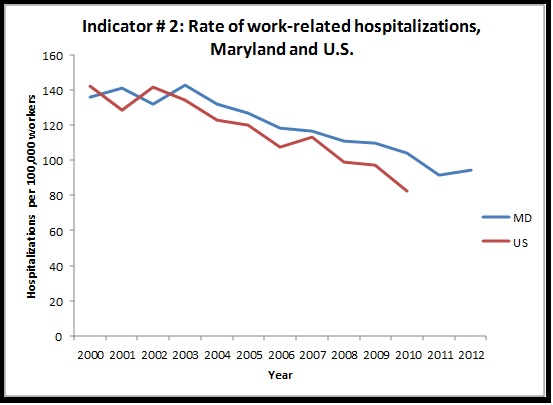Indicator #2 - Work-Related Hospitalizations

Individuals hospitalized for work-related injuries and illnesses have some of the most serious and costly adverse work-related health conditions. Tracking of these hospitalizations can be used to document the burden of occupational injuries and illnesses, to design, target, and evaluate the impact of prevention efforts over time, and to identify previously recognized settings in which workers may continue to be at high risk.
Graph

Indicator # 2: Work Related Hospitalizations, Maryland
| Year | Number | Rate* |
|---|
* Rate per 100,000 workers
|
| 2000 | 3,665 | 135.9 |
| 2001 | 3,844 | 141.2 |
| 2002 | 3,650 | 131.7 |
| 2003 | 3,952 | 142.5 |
| 2004 | 3,641 | 131.8 |
| 2005 | 3,547 | 126.7 |
| 2006 | 3,413 | 118.3 |
| 2007 | 3,354 | 116.8 |
| 2008 | 3,195 | 111.1 |
| 2009 | 3,102 | 110.0 |
| 2010 | 2,932 | 104.0 |
| 2011 | 2,629 | 91.5
|
| 2012 | 2,742 | 94.5
|
| 2013 | 2,336 | 80.0 |
| 2014 | 1,910 | 65.5 |
| 2015 | 1,660 | 55.1 |
| 2016 | 1,590
| 50.1
|
2017
| 1,444
| 46.8
|
2018
| 1,272
| 41.7
|
2019
| 1,096
| 34.4
|
2020
| 904
| 30.5
|
More about this indicator
Why is this indicator important
Individuals hospitalized with work-related injuries and illnesses have some of the most serious and costly work-related adverse health outcomes. Tracking of these significant adverse health effects should be undertaken to document the burden of occupational injuries and illnesses, to design, target, and evaluate the impact of prevention efforts over time, and to identify previously recognized settings in which workers may continue to be at high risk.
Data Sources for this Indicator:
Maryland Hospital Discharge Data (number of work-related hospitalizations); Bureau of Labor Statistics Current Population Survey (total number of employed persons).
A condition was considered work-related if workers' compensation was listed as primary payer in the hospital discharge data.
U.S. data and information about this indicator obtained from http://www.cste.org/general/custom.asp?page=OHIndicators
Limitation of Indicator:
Practice patterns and payment mechanisms may affect decisions by health care providers to hospitalize patients, to correctly diagnose work-related conditions, and/or to list the condition as a discharge diagnosis. Residents of one state may be hospitalized in another state and not be reflected in his/her state’s hospitalization data. All admissions are counted, including multiple admissions for a single individual. Until hospital discharge data is available in all states, aggregation of state data to produce nationwide estimates will be incomplete.

